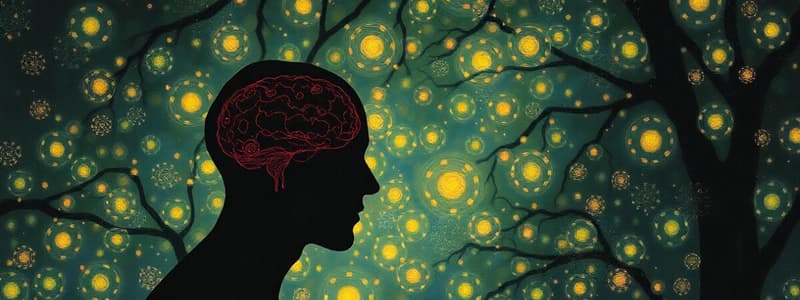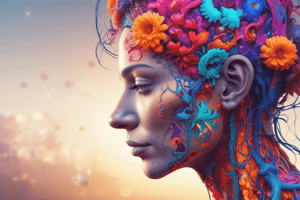Podcast
Questions and Answers
What effect does REM deprivation have on sleep patterns?
What effect does REM deprivation have on sleep patterns?
- It results in decreased total sleep time
- It leads to increased REM sleep later (correct)
- It causes longer sleep cycles
- It has no effect on sleep
Higher body temperature is associated with less REM sleep.
Higher body temperature is associated with less REM sleep.
False (B)
Name a class of drugs that suppress REM sleep.
Name a class of drugs that suppress REM sleep.
Barbiturates
Most OTC sleep aids are __________.
Most OTC sleep aids are __________.
Which of the following is a characteristic of the 'Z drugs' used for treating insomnia?
Which of the following is a characteristic of the 'Z drugs' used for treating insomnia?
Ramelton is a melatonin antagonist.
Ramelton is a melatonin antagonist.
What are the two types of oxerin receptors?
What are the two types of oxerin receptors?
Match the following sleep aids with their characteristics:
Match the following sleep aids with their characteristics:
Which chemical is NOT considered an inhibitory neurotransmitter?
Which chemical is NOT considered an inhibitory neurotransmitter?
The suprachiasmatic nucleus is responsible for regulating wakefulness.
The suprachiasmatic nucleus is responsible for regulating wakefulness.
What is the primary role of orexin in the body?
What is the primary role of orexin in the body?
Caffeine acts as an __________ receptor antagonist.
Caffeine acts as an __________ receptor antagonist.
Match the following neurotransmitters with their roles:
Match the following neurotransmitters with their roles:
What condition is characterized by cell loss in the anterior hypothalamus?
What condition is characterized by cell loss in the anterior hypothalamus?
Stages 3 and 4 of sleep are known as 'Rapid Eye Movement' sleep.
Stages 3 and 4 of sleep are known as 'Rapid Eye Movement' sleep.
How does caffeine affect the activity of dopamine and norepinephrine?
How does caffeine affect the activity of dopamine and norepinephrine?
The brain's 'clock' is referred to as the __________.
The brain's 'clock' is referred to as the __________.
What is the average caffeine content in a cup of coffee?
What is the average caffeine content in a cup of coffee?
Flashcards
REM rebound
REM rebound
Increased REM sleep after periods of REM deprivation.
Insomnia comorbidity
Insomnia comorbidity
Insomnia commonly found alongside anxiety.
Sleep onset
Sleep onset
The beginning of sleep.
Sleep maintenance
Sleep maintenance
Signup and view all the flashcards
Body temperature and sleep
Body temperature and sleep
Signup and view all the flashcards
OTC sleep aids
OTC sleep aids
Signup and view all the flashcards
Z-drugs
Z-drugs
Signup and view all the flashcards
GABA receptor subunits
GABA receptor subunits
Signup and view all the flashcards
Ramelteon (Rozerem)
Ramelteon (Rozerem)
Signup and view all the flashcards
Wakefulness chemical control
Wakefulness chemical control
Signup and view all the flashcards
Reticular Formation (wakefulness)
Reticular Formation (wakefulness)
Signup and view all the flashcards
Hypothalamus (sleep/wake)
Hypothalamus (sleep/wake)
Signup and view all the flashcards
Fatal Familial Insomnia
Fatal Familial Insomnia
Signup and view all the flashcards
Orexin
Orexin
Signup and view all the flashcards
Adenosine
Adenosine
Signup and view all the flashcards
Caffeine's Mechanism
Caffeine's Mechanism
Signup and view all the flashcards
Sleep Stages progression
Sleep Stages progression
Signup and view all the flashcards
REM sleep
REM sleep
Signup and view all the flashcards
Suprachiasmatic Nucleus
Suprachiasmatic Nucleus
Signup and view all the flashcards
Study Notes
Wakefulness
- Wakefulness is regulated by the balance of excitatory and inhibitory neurochemicals.
- Excitatory neurochemicals include glutamate, acetylcholine, dopamine, norepinephrine, orexin, and histamine.
- Inhibitory neurochemicals include GABA, melatonin, and adenosine.
Neural Control of Wakefulness
- Reticular Formation: Releases glutamate in the forebrain.
- Basal Forebrain: Releases acetylcholine in the forebrain.
- Locus Coeruleus: Releases norepinephrine in the forebrain.
- Hypothalamus: Crucial for wakefulness. Damage to the posterior hypothalamus can disrupt wakefulness. Releases histamine and orexin to the forebrain. The loss of orexin-producing neurons causes narcolepsy.
- Suprachiasmatic Nucleus (SCN): The brain's internal clock, controlling melatonin release by the pineal gland.
Caffeine
- Caffeine is an adenosine receptor antagonist.
- Adenosine suppresses excitatory neurochemicals (dopamine, norepinephrine, glutamate, acetylcholine) and enhances GABA activity.
- Adenosine accumulates during the day.
- A cup of coffee contains ~100 mg of caffeine, a can of soda ~40 mg.
- Caffeine is metabolized by CYP-IA2.
- Half-life is ~4 hours, with active metabolites extending effects.
- Caffeine constricts cerebral vessels, aiding in headaches.
- Coffee consumption may protect against type 2 diabetes, cancer, Parkinson's, Alzheimer's, cardiovascular disease, and improve memory, but it can exacerbate anxiety.
Sleep Stages
- Brain activity varies during wakefulness.
- Brain activity becomes increasingly rhythmic from Stages 1 to 4 (slow-wave sleep).
- Sleep isn't the absence of brain activity.
- Stages 3-4 slow wave sleep are characterized by rhythmic brain activity, presumably as the hypothalamus stops sending signals to the cortex.
- REM sleep is linked to body temperature.
- REM deprivation leads to REM rebound.
- Some drugs (e.g., barbiturates, alcohol) suppress REM sleep.
- Higher body temperature correlates with more REM sleep.
Insomnia
- Insomnia is highly comorbid with anxiety.
- Types of insomnia include onset, maintenance, and termination.
- Body temperature falling promotes sleep onset, while rising temperature promotes wakefulness.
Sleep Aids
- Many over-the-counter sleep aids are antihistamines, with the 'Z-drugs' (e.g., Zolpidem, Zaleplon, Eszopiclone) considered for insomnia.
- These are Non-benzodiazepine receptor agonists (NBZRAs) with varying half-lives (1-6 hours).
- These bind to 1-2 GABA receptor subunits, not all 5.
- Some sleep aids can cause amnesic states.
- Ramelteon (Rozerem) is a melatonin agonist with a questionable efficacy.
- Oxerin receptor antagonists (e.g., Suvorexant - Belsomra) target orexin pathways, preventing arousal system activation. Orexin is a peptide neurotransmitter regulating sleep-wake transitions.
Studying That Suits You
Use AI to generate personalized quizzes and flashcards to suit your learning preferences.



